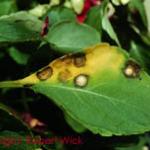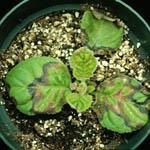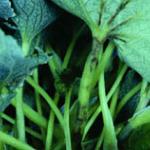Impatiens Necrotic Spot Virus and Tomato Spotted Wilt Virus
Introduction
Tospovirus is a virus family that includes Impatiens Necrotic Spot Virus (INSV) and Tomato Spotted Wilt Virus (TSWV). Almost all greenhouse crops are susceptible except for poinsettias and roses; many vegetables are also susceptible. These viruses are spread from plant to plant in greenhouses and in the field by thrips feeding activity. Both Western flower thrips (Frankliniella occidentalis) and onion thrips (Thrips tabaci) are capable of spreading INSV. Seven species of thrips are known vectors for TSWV, including Western flower thrips. Efficient transmission of TSWV by onion thrips appears to be a genetically recessive trait; therefore, some populations of onion thrips can transmit TSWV, while others cannot. Both INSV and TSWV have very broad host ranges. More than 600 plant species are known to be susceptible to INSV. TSWV has the widest known host range of any plant virus, affecting over 800 plant species (as many as 1,000 according to some sources).
Symptoms on Greenhouse Crops
The name of TSWV was derived from the symptoms (spotting followed by wilt) that develop on tomato. Similarly, the name of INSV was derived from symptoms (necrotic ringspots) on Impatiens. On other hosts, ringspots, purple to black lesions on leaves and stems, flower color breaking, stunting, death of terminals, and wilt may occur. The stage of growth can also influence symptom development.
For many hosts, symptoms are not well known or are not described; however, in some commonly infected crops, symptoms can be diagnostic. Gloxinias infected as young plants develop necrosis of the central leaves, resulting in collapse. Older Gloxinias develop necrotic ringspots on the foliage, as well as necrosis along the veins.
Cineraria develops chlorotic ringspots and/or mottling on the upper leaf surface, and purple to black lesions on the veins underneath. On Exacum (persian violet), the virus causes tan to dark brown cankers on stems. Reiger begonias develop necrotic ringspots, mosaic, and necrosis of the leaf veins. Symptoms on Impatiens and New Guinea impatiens include stunting, leaf distortion and blackened spots or rings on foliage and stems. In some cases, terminals will die and the entire plant may collapse. As with other virus diseases infected plants may remain symptomless for a period of time.
Symptoms on Vegetable Crops
In Massachusetts, tospoviruses are most frequently noted on pepper and tomato. On pepper the foliage becomes distorted and the fruit develop circular rings that are slightly indented into the skin. On tomato, foliage becomes spotted and blackened particularly on the inner leaflets toward the top of the plant. The growing point may also become necrotic and the whole plant may wilt. Fruit symptoms are variable. Small necrotic spots to large circular blotches may develop.
Life History
In greenhouses, the most important vector of TSWV and INSV is considered to be the western flower thrips (WFT). The viruses are associated with thrips in a persistent manner. Both viruses may also be spread by vegetative propagation of infected plant material.
WFT can acquire TSWV and INSV only during the larval stages, but once infected, the thrips remains so for the rest of its life. Thrips acquire the viruses after feeding for about 30 minutes on an infected plant. After a latent period of 3-18 days the thrips is capable of transmitting the virus to any susceptible plant it feeds on. Because the larval stages tend to be brief and pupae do not feed, adult thrips are primarily responsible for spreading these viruses. During feeding, saliva is injected into the plant cell and the contents withdrawn. When tospoviruses are present in the saliva, these are transmitted to the plant during the feeding process in as little as 15-30 minutes. Uninfected adult WFT cannot acquire the virus from tospovirus-infected plants because tospoviruses pass right through the gut and do not enter the salivary fluid. Adults do not transmit the virus amongst themselves, and there is no transmission from adults to eggs. Overlapping generations of thrips within a greenhouse may result in continuous virus transmission. In greenhouses tospoviruses can be perpetuated through successive crops and weeds, resulting in losses year-round. Tospoviruses have not been observed to spread significantly in field-planted vegetable crops in Massachusetts, possibly because most thrips species do not compete well in the outdoor environment.
Test Kits to Detect Tospoviruses
On-site test kits can be used to detect the presence of tospoviruses in plants. These are simple to use and are available from Agdia (www.agdia.com). There are separate tests for TSWV and INSV. If a plant is suspected of being infected with a tospovirus, a tissue sample can be collected from those parts of the plant showing symptoms. Even when plants are systemically infected, tospoviruses do not spread evenly throughout the plant, so the careful selection of tissues is crucial to the success of the test. Use a nickel-sized sample from the part of the plant showing symptoms, including green or chlorotic tissues adjacent to the necrotic area.
Another option for detecting tospoviruses is to send a plant sample to a plant disease diagnostic clinic. Samples may be sent to the University of Massachusetts Plant Disease Diagnostic Lab.
One problem with testing for viruses is that some host plant species do not express TSWV or INSV symptoms until long after the initial infection. Cyclamen, for example, can show no symptoms for up to two months after infection.
Management
Plants infected with tospoviruses cannot be cured. Elimination of infected plant material and WFTs are the most important management practices. Newly-acquired plant shipments should be inspected carefully for evidence of thrips and symptoms of virus before being introduced into the greenhouse. Symptomatic plants should be discarded or isolated and the supplier should be notified after laboratory confirmation of the disease. Since various weed species can harbor the viruses, thorough weed control is important. If possible, keep vegetatively propagated plants isolated from those produced from seed. Do not grow vegetable transplants in the same greenhouse with susceptible ornamentals. Thrips populations should be monitored with sticky traps. Since only a small number of infected thrips is necessary to start an epidemic, thorough control of WFT should be the goal.
For more information on the life cycle and management of thrips see the fact sheet:
Western Flower Thrips and Tospovirus
Resources
L.B. Stack New England Greenhouse Floriculture Guide, A Management Guide for Insects, Diseases, Weeds and Growth Regulators. New England Floriculture Inc.
Fact Sheets: Western Flower Thrips and Tospovirus (from list)
Diagnostic Test Kits (from list)



